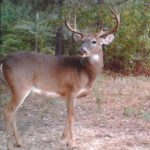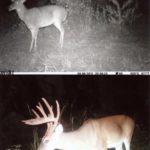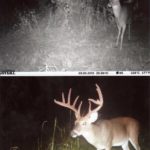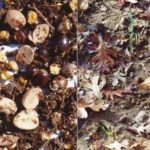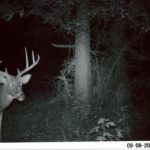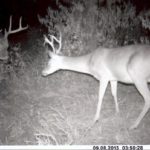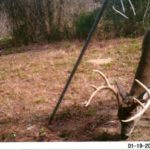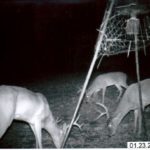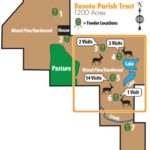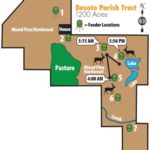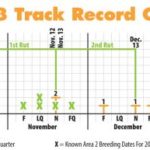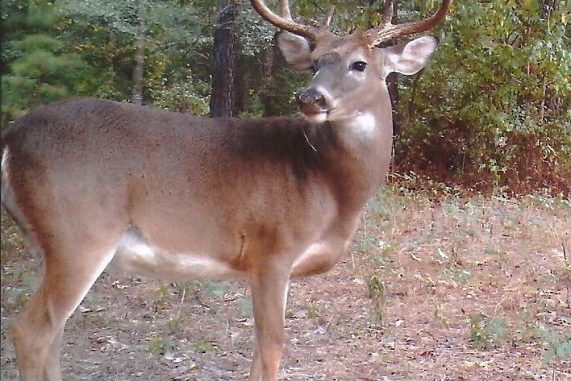
Deer management is all the rage today, introducing the concept of passing up bucks to allow them to mature. Sometimes it pays off, and sometimes it doesn’t.
Probably the one thing that I have ever written about deer hunting that is worth remembering is this: If you see a deer while hunting and you think you should shoot it, you probably should because in our Louisiana environment the opportunity might not come again.
The January 2013 issue of Louisiana Sportsman included my story about a Boone and Crockett buck in Desoto Parish that I had been tracking for three years.
In 2010 the buck was a 140-class 10-point, in 2011 it was a 170-class 13-point and in 2012 the buck was a great 160-class 11-pointer.
A photograph of the buck before writing last year’s story was taken on Oct. 23, 2012, as the buck was walking past a feeder in one of the green patches. Little did I know that would be the last photograph of the buck for the year.
My closing statement in the article concerning this buck was that if the buck continued to maintain its small home range, it just might be around for the 2013 season.
During the remainder of the 2012 hunting season, I kept waiting to see the buck at one of the feeders that it often visited, but it never materialized.
This year I set cameras out at the two main sites it visited, put out 100 pounds of rice bran at each site and hoped the buck’s photo would be on one of the cards.
When I returned four weeks later, there were over 1,000 photos on each camera card. The big 8-pointer I also tracked last year was on the card. The nice young 8-pointer that briefly battled the big 8 was on the card, as were smaller bucks and does and fawns. And, there were three photos of another big 8-point still in velvet (the big 8 and smaller 8 had lost their velvet as of Sept. 1) that bore a striking resemblance to the B&C 11-pointer.
On that visit, the feeders were set back up with two more cameras, and on my next visit I hopefully will be able to verify for certain if it is the Booner.
Look at the photos and decide for yourself.
Data from Mississippi State University and Texas A&M Kingsville suggests that by 5 ½ years a buck has basically reached its peak for antler growth. If this buck is 6 or 7 years old, that would easily explain why it is on the decline.
So what happened to this great buck last year? Why did it all of a sudden disappear right as the Area 2 rut was cranking up?
It had basically kept the same small winter range for the past two years during the rut. Perhaps it went on what biologists call an excursion and found a new niche (home range) for the year.
When I first encountered the buck in 2010, it was at least 3 ½ years old based on body and antler mass. It could have been 4 ½ years old, but I am thinking it was only three.
If you recall, Northwest Louisiana was experiencing drought conditions in 2010, and this buck grew an impressive set of antlers — at least 140 inches B&C — despite the poor growing conditions, and would have put a bow hunter in the archery record book.
I used this buck in several “shoot, don’t shoot” articles and suggested that gun hunters should pass on it since it would not make any gun records and based on it being a young buck with nice G-2s and G-3s, the buck would be better.
The drought continued in 2011, and it was exciting to see that this buck became a true 170-class B&C buck despite poor habitat conditions. This just goes to show how exceptional these once in a lifetime bucks are: The DNA makeup of this buck was such that, despite drought conditions, it had the ability to grow antlers. In fact it increased over 40 inches.
In 2012, the buck was only an 11-point but still sported 160-class antlers and was either 5 or 6 years old. As bucks grow older they will fall out of the social hierarchy and become somewhat solitary in behavior.
Maybe it found a place that suited him better without the stress of the rut, especially from the interaction and fighting with other bucks such as the big 8.
There was no mast crop in 2010 and 2011, but acorns — especially cow oak acorns — were abundant in 2012. White oaks are a preferred food of deer, and with plenty of acorns in the woods there was no need to visit the feeders.
Keep in mind that there is no hunting on these 1,200 acres. No hunting and very little disturbance means deer can come eat at a feeder whenever they want, but as the track record shows, they do not.
This tells me they prefer acorns over corn.
The big 8-pointer was also a mature 5- or 6-year-old buck in 2012, could have run off the bigger buck as it exerted his dominance among the other bucks. Another thought was that the Booner could have been killed by someone hunting on adjacent lands, but to my knowledge no one came forward last year wanting to get it scored for the records.
B&C bucks in Desoto Parish are virtually nonexistent in our records and it is hard to believe someone would keep quiet about it — unless it was illegally taken, which was another possibility.
Lessons from the Booner
Life is about growing and learning, and this buck has given us some good insight into deer movement and management in Louisiana.
Hunting in Louisiana, with winter weather that is greatly influenced by the Gulf Coast, can be hit or miss. In 2012, the winter weather was on the very mild side, and deer movement was poor overall and much reduced.
When we do get cold fronts, they are often short-lived; therefore it is a must that Louisiana hunters hunt on those days when deer are most likely to be moving.
The track record of the 2011 13-point Booner testifies to this. From mid-October through December, a total of 77 camera days, the buck visited feeders 19 times (19/77= 25 percent). So to begin with, the total visits to feeders was a quarter of the hunting days.
This should say something to a hunter who spends his entire deer season sitting on a feeder.
Of those 19 days when the buck showed up at the feeder, 13 visits at night and six occurred during daylight hours. Now, 6/77 equates to 8 percent of the total hunting days — not good odds for someone trying to kill it.
All of these daytime visits were associated with cold fronts.
On one occasion the buck moved the day before the front, another time it moved while the front was passing through, another time the second day after the front, another time the third day after the front. On two of those six days it moved right at last light.
In other words, there was really no distinct pattern other than it moved in response to a cold front, which implies that deer activity will occur at some time during a cold front, so stay with it. This works especially well for us retired folks.
Another lesson is for us deer managers. Bucks that show good potential, such as this buck did when it was a 10-pointer, will grow larger as it gets older. Beam length, brow tines, length of G-2s and G-3s are indicators of future growth parameters. I think the G-2 and G-3 lengths are especially important.
But there is a limit, and this is when hunters should be ready to squeeze the trigger.
2011 would have been the year to harvest the buck. Antler growth declined in 2012, probably due to the age factor, and it would not score as high as it did the previous year.
Unfortunately the buck disappeared in 2012 and gave no harvest opportunity. Passing on the buck in 2011 and hoping it would get better would have been a big mistake, since the buck declined the next year and then disappeared.
If the 8-pointer in the photos this year is indeed the Booner, it could be 7 years old and on the way down (although it is a great 8-pointer), then for certain 2011 would have been the year to shoot the buck.
The pattern of the Booner in 2011 clearly shows that we need to know when the rut occurs and hunt it.
The buck followed the typical pattern of bucks during the rut. They feed heavily during the pre-rut (in Area 2 this is September) in preparation for the rut. When the rut approaches the bucks work scrapes, start looking for does in estrus, begin chasing and breeding, and basically disappear from the feeding sites.
As the first round of breeding declines, the bucks visit the feeding sites briefly, and then they go into the repeat mode: scrape, chase and breed.
When the post-rut begins following this second round of breeding, they go back to the feeding mode, occasionally chasing a doe or two that has a late cycle.
When the rut hits, hunting travel corridors between the feeding sites and your permanent stands can spell success.
While the verdict is not in as to whether this 8-point buck is the Booner, I feel blessed to have had the three-year encounter with it. Even though the 11-point buck disappeared during the 2012 season following the pre-rut, I was able to track the 8-pointer during the entire 2012-13 deer season.
And while this buck is not a Booner, we can learn much from its track record.
Tracking the Big 8
The big 8-pointer is an impressive buck, and last season it was at least 4 ½ years old.
Looking back at the 2011 photos, there was a nice 8-pointer with small brow tines and good G-2s that could very well be this deer.
The big 8 this year has somewhat heavier mass than last year, and the tines look longer. Again, research shows that antler mass and size will increase up to a point, and then begin to decline.
The 8-pointer will not score great, but it would put a bow hunter in the P&Y Record Book. So it is going to be fun tracking it again this year.
Just like the Booner, the big 8 maintained a small home range, just like the two telemetry studies done by LSU/LDWF demonstrated.
The crawfish pond feeder was in the heart of its core area, and it occasionally visited the big white oak feeder site (this is the site that the Booner frequented).
Basically, the home range during the winter was less than 300 acres. The fact that these big bucks maintain small home ranges during the rut is good news to small land owners practicing quality deer management.
Age is a key ingredient to producing big bucks and, as we have learned from the past, heavy buck-hunting pressure doesn’t let bucks grow older.
Just like the Booner in 2011, the big 8 made very few trips to the feeders in 2012.
It was photographed at feeders nine times during the pre-rut in September. From Oct. 1- Jan. 31 — a total of 123 days — the buck made 10 visits to the feeders, of which only five were during legal shooting hours.
Harvest opportunity was even less for the big 8 than for the Booner: A hunter had a 4-percent chance (5 out of 123 days) to connect with the buck.
The season is long, but the harvest opportunity is limited. And, just like with the Booner, the opportunities for success are tied in with the cold fronts.
Hunters had zero opportunity in October to harvest this buck. A cold front in mid-November had the big 8 feeding at a feeder on Nov. 15, and then at a different feeder on Nov. 16 during daylight hours.
It made another visit during daylight hours to a feeder on Nov. 28 in response to another cold front, and then was photographed passing by a feeder on Dec. 28 — probably in pursuit of one of the last does that was in estrus.
The final visit to a feeder was on Jan. 19, the last Saturday of the primitive season, and the time was 12 noon.
Now how many hunters in Area 2 were in their stand on the last weekend of the 2012-13 deer season with their muzzleloader? Not too many — most had put their guns away and were finishing up with the last football games.
To top it off, the buck was at a feeder it had never before visited. So much for trying to outsmart these critters.
While the big 8-pointer did not disappear like the Booner, the track record of it during the 2012-13 season was pretty much a flat line.
As soon as the acorns started falling and the rut kicked in, visits to the feeders dropped big time: three daylight visits in November, none in December and one during daylight in January.
As I said, there was a very good white oak acorn and red oak crop in the woods, so deer really did not need to eat corn because there was plenty of food being provided by Mother Nature.
Hunters probably get tired of hearing it, but when there are acorns in the woods, deer are going to be eating them and the strategy should change from hunting feeders to hunting the native food.
Add to this the very mild 2012 winter, and the need to feed was not too strong.
The idea of hunting between the permanent stands and feeders — hunting the travel corridors — is evident by the movement of the big 8 on Dec. 30.
The buck was at the crawfish pond feeder at 4 a.m., at the big white oak tree feeder at 5:15 a.m. and at the lake feeder at 5:56 p.m.
It was not feeding, just looking — probably for the last remaining does that might be in estrus.
While most of the does are bred during the first breeding period, buck activity and movement can be really good during the second breeding period as bucks compete for those last remaining does in heat. I always try to save one tag for the late rutting period just for this reason.
So, the bottom line is the rest of the story might not be the rest of the story. Good news for us guys who make our living writing stories!
